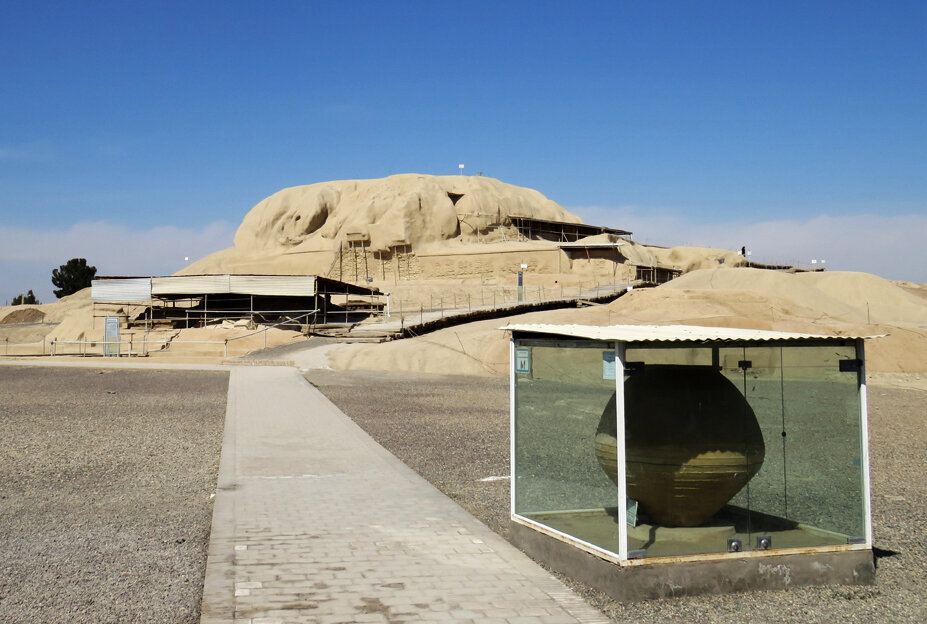Reassessment project at Tepe Sialk enters third phase

TEHRAN – The third phase of a reassessment project has commenced at Tepe Sialk, a treasured ancient site situated near Kashan in Isfahan province.
Authorized by the Research Institute of Cultural Heritage and Tourism, the excavation is co-led by Jebrael Nokandeh and Javad Hosseinzadeh Sadati, and is expected to continue until the end of September.
According to Mehr news agency, Nokandeh stated that the Sialk Reassessment Project is a long-term research initiative aimed at organizing and updating [previous] archaeological studies at the site.
The project was founded by the late Sadeq Malek Shahmirzadi, who supervised its first phase from 2001 to 2005. The second phase was led by Hassan Fazeli Nashli from 2008 to 2009. The third phase began in 2022 under the direction of Nokandeh and Hosseinzadeh Sadati, with the current season marking its third phase of work.
The ongoing phase is a collaborative effort involving the National Museum of Iran, the Archaeology Research Center of the country, and the Department of Archaeology at the University of Kashan. It aims to answer various research questions related to the central Iranian region, spanning from the Neolithic period to the early Achaemenid era. The project also seeks to improve conditions for displaying the site’s archaeological findings to both Iranian and foreign visitors.
Nokandeh on Saturday explained that this season focuses on continuing last year’s work and achieving a more in-depth understanding of the site's most recent layers.
Among the significant discoveries so far is an industrial workshop, approximately 8 meters long and 2 meters wide, likely linked to metalworking activities from the sixth Sialk period (about 2800 to 2600 years ago).
The workshop features a longitudinal wall on its western side and two transverse walls to the north and south. It appears to have lacked an eastern wall, and its roof was probably supported by wooden beams.
Evidence found on the workshop floor includes a small heat-affected pit (possibly a crucible placement), grinding stones, and ash, indicating its function as a metallurgical site. Additionally, a fragment of a bellows pipe was discovered among the eastern debris, further supporting the workshop's identified use.
Another notable find from this season is a collection of pottery from the Sialk IV period (5300 to 4900 years ago), comprising a large pottery jar, two bowls known as rimmed bowls, parts of a painted pottery cup, and a portion of a jug. These items were located beneath structures from the Sialk VI period, and their context remains unclear, pending further investigation in future seasons.
Nokandeh expressed hope that the ongoing excavations will uncover new evidence regarding the final settlement phases at the significant Tepe Sialk site, potentially shedding light on the reasons behind the site's abandonment in the late Median period.
Situated halfway between Kashan and Fin in Isfahan province, Tapeh Sialk (“Sialk Hills”) has yielded interesting pottery pieces, metal tools, and domestic implements made from stone, clay, and bone that date from as early as the 4th millennium BC.
In 2019, the Louvre museum hosted a worldwide gathering on Tapeh Sialk, which was attended by archaeologists from Germany, England, France, and Iran. According to the Louvre, the event was aimed to cast a new light on the ancient site some 80 years after its first excavation to lay an opportunity to present to the public the diversity of research and projects, as well as current issues of preservation and enhancement of the site.
As per the Louver, the oldest levels document the occupation of the Iranian plateau from the Neolithic to the Chalcolithic over more than two millennia. Then, around 3000 BC, the site was integrated into the vast cultural area called Proto-Elamite, during which specific writing appeared.
AM
Leave a Comment